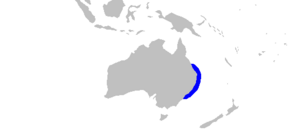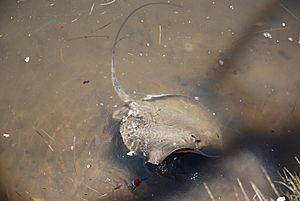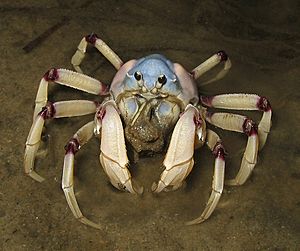Estuary stingray facts for kids
Quick facts for kids Estuary stingray |
|
|---|---|
 |
|
| Conservation status | |
| Scientific classification | |
| Genus: |
Hemitrygon
|
| Species: |
fluviorum
|
 |
|
| Geographic range | |
The estuary stingray (Hemitrygon fluviorum) is a type of stingray. People also call it the estuary stingaree or brown stingray. This ray lives only in eastern Australia.
You can usually find it in shallow tidal rivers. It also likes estuaries and bays that have mangrove trees. These areas are mostly in southern Queensland and New South Wales.
The estuary stingray is yellow-brown to olive in color. It can grow to be at least 93 centimeters (about 3 feet) wide. It has a body shaped like a diamond. Its tail is long and thin, like a whip. The tail also has folds of skin on the top and bottom.
You can spot this ray by its long, narrow nostrils. It also has a line of thorns down the middle of its back.
Even though some people think it eats a lot of oysters from farms, it mainly eats crabs and worms. Baby stingrays grow inside their mother. They get food from a special "uterine milk."
This stingray used to be very common. But its numbers have gone down a lot. This is likely because its home is being damaged. It also gets caught by accident in fishing nets and by people fishing for fun. Sometimes, shellfish farmers also harm them.
Because of these problems, the IUCN has listed the estuary stingray as Vulnerable. This means it is at risk of becoming endangered.
Contents
What is an Estuary Stingray?
Naming the Estuary Stingray
The first time anyone wrote about the estuary stingray was probably in the 1800s. An English naturalist named William Saville-Kent saw a "common stingray" eating oysters in Queensland.
Later, an Australian fish expert named James Douglas Ogilby officially described the species. He wrote about it in 1908. He based his description on a stingray found in the Brisbane River.
The name fluviorum comes from Latin. It means "of the rivers." This name fits well because the stingray often lives in rivers.
How to Spot an Estuary Stingray
The estuary stingray has a body shaped like a diamond. It is about as wide as it is long. The front edges of its body are gently curved. Its outer corners are nicely rounded.
Its snout, which is like its nose, is wide and shaped like a triangle. It narrows down to a point. The stingray has small eyes that are far apart. Right behind its eyes are small holes called spiracles.
Between its long, thin nostrils, there is a short, wide flap of skin. Its mouth is small and shaped like a bow. Inside its mouth, it has five small bumps called papillae. Its teeth are tiny and form flat surfaces, like a pavement. It also has five pairs of gill slits under its body. Its pelvic fins are quite large.
Its tail is twice as long as its body. It is wide and flat at the base. On the top of its tail, it usually has one or two stinging spines. These spines have jagged edges. After the spines, the tail quickly becomes thin like a whip. It has a ridge on top and a long, low fin fold underneath.
The stingray's skin has small, flat scales called dermal denticles. These are found between its eyes and over the middle of its back. It also has a line of larger thorns down its back. These thorns get longer as they get closer to the sting. The rest of the tail is smooth.
The estuary stingray is yellowish to greenish brown on top. It gets lighter towards the edges of its body. It gets darker past the tail spine. Its underside is white. It can grow to be at least 93 cm (3 feet) wide. Some might even reach 1.2 meters (4 feet) wide. The heaviest one ever recorded weighed 6.1 kg (13.4 pounds).
Where Estuary Stingrays Live
The estuary stingray lives along about 1,700 kilometers (1,050 miles) of Australia's eastern coast. You can find it from Repulse Bay in Queensland to the Hacking River in New South Wales. It is most common in southern Queensland. This includes places like Hervey Bay and Moreton Bay.
People once thought this stingray had disappeared from Botany Bay and Port Jackson in the 1880s. But recent sightings show it is still there. Some old records from other places, like the Cape York Peninsula or New Guinea, were probably mistakes. Those were likely other types of stingrays.
Their Favorite Homes
Estuary stingrays are quite picky about where they live. You only find many of them in certain places. They prefer tidal rivers and the flat, muddy areas of estuaries and bays. These areas often have mangrove trees and sandy or muddy bottoms.
This stingray rarely leaves these sheltered areas. However, it has been seen in deeper offshore waters, up to 28 meters (92 feet) deep. It lives in salty ocean water and brackish water (a mix of fresh and salt water). It might even be able to live in fresh water. It has been known to swim up rivers past where the ocean tide reaches.
The water temperature where they live changes with the season. In the north, it's about 24–29°C (75–84°F). In the south, it's cooler, about 17–23°C (63–73°F). It seems that stingrays of different sizes and sexes live in different areas.
Life of an Estuary Stingray
Some people believe estuary stingrays eat a lot of oysters and other shellfish from farms. But their main diet is actually crabs and worms. In Moreton Bay, a very important food for them is the soldier crab.
These rays have been seen going into mudflats as the tide comes in. They do this to search for food. Like all animals, they can have parasites. Some parasites found on estuary stingrays include certain tapeworms and nematodes.
How They Have Babies
Like other stingrays, the estuary stingray gives birth to live young. The babies grow inside the mother. At first, they get food from a yolk sac. Later, the mother produces a special "uterine milk" (called histotroph) to feed them. Females likely have babies every year.
Scientists have seen males and females courting at night. The male follows the female and gently bites her body. This happens in places like Hays Inlet from July to October. The water is usually about 80 cm (31 inches) deep.
Newborn stingrays are about 11 cm (4.3 inches) wide and 35 cm (14 inches) long. Young rays have been found in rivers like the Nerang River and Macleay River. These fresh or brackish areas might be like nurseries for the young rays.
Males become adults and can have babies when they are about 41 cm (16 inches) wide and seven years old. Females become adults when they are about 63 cm (25 inches) wide and 13 years old. This big difference in size between males and females becoming adults is unusual for stingrays. Males can live up to 16 years, and females can live up to 23 years.
Estuary Stingrays and People
Evidence suggests that the estuary stingray, which used to be common, has greatly decreased in numbers. Even though people don't usually fish for them to sell, they face many dangers.
They often get caught by accident in large commercial fishing nets. This is called bycatch. Sometimes, fishermen will harm them to remove them from nets. People who fish for fun also catch them often, and sometimes kill them. Surveys in Moreton Bay found that over 10% of the stingrays had signs of being caught, like hooks or damaged tails.
Damage to their homes is another big threat. This is especially true because they need specific places to live. Many of the areas where they live are now very developed. This means there is a lot of land reclamation (creating new land from water), water pollution, and building of flood barriers on rivers.
Finally, because these rays sometimes eat shellfish, some shellfish farmers see them as a problem. This has led to them being harmed by farmers.
Because their population is shrinking and they face many threats, the IUCN has listed the estuary stingray as Vulnerable. This means they are at risk. Studies show they could become endangered if nothing is done to help them.
Some Marine Protected Areas (MPAs) exist where they live. But these areas don't always protect them enough from fishing. Since they are still common in Hervey Bay and parts of Moreton Bay, these places are very important for saving the species. The Queensland government is working on plans to help protect the estuary stingray.
See also
 In Spanish: Hemitrygon fluviorum para niños
In Spanish: Hemitrygon fluviorum para niños




